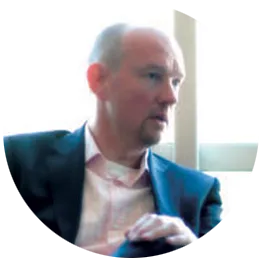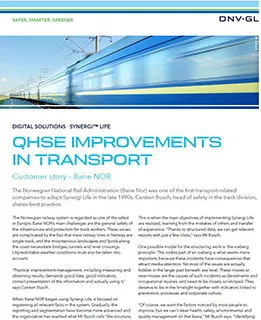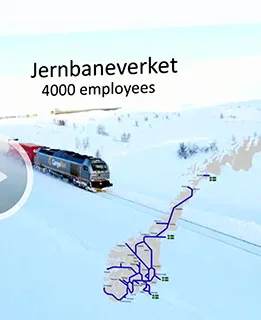Bane NOR adopted Synergi Life in the late 1990s
The Norwegian National Rail Administration (Bane NOR) was one of the first transport-related companies to adopt Synergi Life in the late 1990s. Carsten Busch, head of safety in the track-division, shares best practice.
The Norwegian railway system is regarded as one of the safest in Europe. Bane NOR’s main challenges are the general safety of the infrastructure and protection for track workers. These issues are complicated by the fact that most railway lines in Norway are single-track, and the mountainous landscapes and fjords along the coast necessitate bridges, tunnels and level crossings. Unpredictable weather conditions must also be taken into account.
“Practical improvement management, including measuring and obtaining results, demands good data, good indicators, correct presentation of the information and actually using it,” says Carsten Busch.
Structure, consistency and quality
When Bane NOR began using Synergi Life, it focused on registering all relevant facts in the system. Gradually, the reporting and segmentation have become more advanced and the organization has reached what Mr Busch calls “the structure, consistency and quality phase.” This is when the main objectives of implementing Synergi Life are realized, learning from the mistakes of others and transfer of experience. “Thanks to structured data, we can get relevant reports with just a few clicks,” says Mr Busch.
One possible model for the structuring work is ‘the iceberg principle’. The visible part of an iceberg is what seems more important, because these incidents have consequences that attract media attention. Yet most of the issues are actually hidden in the larger part beneath sea level. These misses or near-misses are the causes of such incidents as derailments and occupational injuries, and need to be closely scrutinized. They deserve to be in the limelight together with indicators linked to prevention, processes and corporate culture.
“Of course, we want the factors noticed by most people to improve, but we can’t steer health, safety, environmental and quality management on that basis,” Mr Busch says. “Identifying events that lead to the ‘above-surface’ incidents are what we need to focus on.”
Bane NOR has created a follow-up system involving a regular check of whether case-handling and classification have been appropriate. Moreover, it verifies that the action taken makes sense in the long run – preventing the same incidents from recurring. “This way, we find good solutions and let everyone know about them,” Mr Busch says.
Bane NOR tries to handle every single case in Synergi Life as it occurs, as well as monitor trends for various case types. The case does not necessarily have to go through all the stages in the Synergi Life handling process before the problem is fixed. Case registering and handling is done mainly by dedicated HSE&Q personnel, whilst action can be taken by anyone within the organization.
One thing that helps build a safety culture is highlighting the link between goals, indicators and actions, as well as the connection between top-level events, underlying causes and actions in a structured and logical way. “Make it simple and readily accessible for everyone – use colours, smileys or speedometers to show the position,” he says.
Besides registration, classification, case handling with action tracking and input for risk analysis, Synergi Life is used by Bane NOR to report directly to the regulator, the Norwegian Railway Inspectorate. “Since the inspectorate also uses Synergi Life, it continuously receives fresh information from us,” says Mr Busch. “The rules say that the National Accident Board should be alerted within 24 hours if a case is classified as ‘very serious’ in Synergi Life. In that event, the risk management system ensures that the accident board will have an e-mail sent to it within four hours.
“Synergi Life is extremely flexible and powerful. But no tool works on its own. Building a QHSE culture in a positive way is crucial, with the tool as an integrated component,” says Mr Busch.
Top reason why we chose Synergi Life software:
- Synergi Life is extremely flexible and powerful
This is what we gained:
- Important learning from others' mistakes and the transfer of experience
- Relevant reports with just a few clicks
BANE NOR IN BRIEF
The Norwegian National Rail Administration (Bane NOR) is the national authority responsible for operating, maintaining and developing Norway's rail network. Its responsibilities include:
- Managing rail traffic
- Planning and producing timetables
- Allocating track capacity between different train operating companies and providing Norway's train operating companies with safe and efficient transport infrastructure
- Planning, improving and maintaining the rail network, including stations and freight terminals




